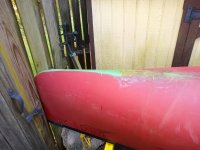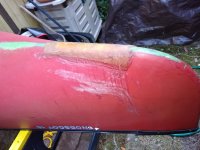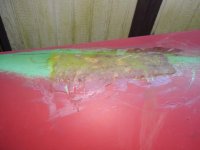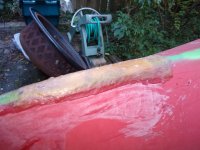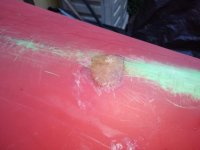- Joined
- Sep 28, 2018
- Messages
- 8
- Reaction score
- 0
I recently got a bargain on a 31 year old Old Town Penobscot in Royalex. It has 4 different, sloppily done, epoxy/glass-mat repairs by the previous owner (see photos). He did them all on the outside (no interior holes or patches are visible), it looks like with automobile epoxy/glass-mat. The 2 major repairs are on the bow & stern keel areas, where no one had ever put on skid plates. I plan on putting on Dynel skid plates (after reading about them here), but I'm wondering if I should sand off, and re-do the current repairs, given how thick and amateurish they are.
They look solid, and I could sand off just a bit...and make the skid plates big enough (really big!) to cover them.
Or I could sand them completely off and start from scratch. (As far as I know....the previous owner did stop it from leaking....)
As you can see from the green ABS showing....the boat badly needs large skid plates....
Any advice from you seasoned canoe repairers????
They look solid, and I could sand off just a bit...and make the skid plates big enough (really big!) to cover them.
Or I could sand them completely off and start from scratch. (As far as I know....the previous owner did stop it from leaking....)
As you can see from the green ABS showing....the boat badly needs large skid plates....
Any advice from you seasoned canoe repairers????

